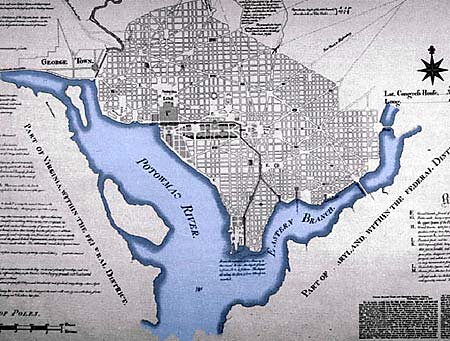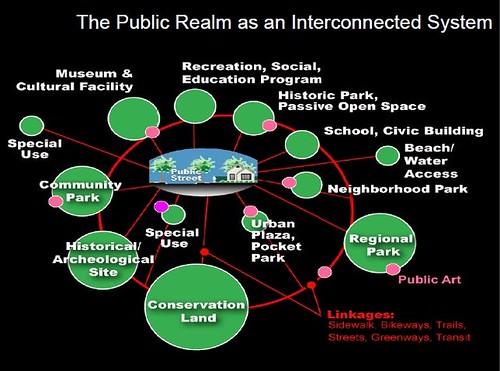It's the generations, stupid
It is true that the city that can grow faces different challenges from a city that must shrink in a climate of disinvestment.

Lydia DePillis' Housing Complex and City Paper cover story, "Walk This Way: Expanding pedestrian and bike safety to the whole District won’t be easy," discusses this in the context of the DC Department of Transportation.
Although for me, I have been thinking about this more broadly, that it's not just about walking and biking, although they often serve as placesetters for broader livability issues, that it's about creating a master city livability agenda more broadly, in terms of land use planning, transportation, parks, recreation, and open space, commercial district revitalization, etc. Basically the points that are made by parks planner David Barth, as I have discussed before, in many pieces, including this one, "Breakthrough parks planning in DC requires visionary leadership."
- (with Carlos Perez) Leadership and the Role of Parks and Recreation in the New Economy.
- Parks System Master Plans: Tools for Sustainable Communities
- City of Tampa Parks Master Plan appendix discussion of Barth's "City Revival" approach, linking new urbanism concepts with the City Beautiful movement

Slide from presentation, Leadership and the Role of Parks and Recreation in the New Economy, David Barth
Sadly, the Committee of 100 on the Federal City, one of the two main neighborhood-city beautiful organizations in the city (the other is the DC Federation of Civic Associations), doesn't get that in a climate that favors investment, growth, and an influx of new residents, that they too need to think differently about the future, the future of the city, and how to react and be not just reactive, but proactive.
The Housing Complex also reports on this, in "Committee of 100 to Gray: Sack Klein, Tregoning." From the article:
Well now, the Committee of 100 has gotten a bee in its bonnet: President George Clark blasted off a letter to incoming Mayor Vince Gray this week calling for the replacement of Department of Transportation director Gabe Klein and Office of Planning director Harriet Tregoning.
The letter cites a litany of complaints, most centering around what Clark sees as a disregard for community input (by which he means their input) and the aggressive pursuit of a smart growth vision (which the Committee of 100 doesn't share). He also accuses Klein's DDOT of neglecting basic services while pursuing shiny toys, and even of losing the city a federal grant for streetcars with his poor planning abilities. Overall, the letter makes clear that the Committee of 100 has felt very abused over the last several years.
"It is offensive to many neighborhood groups to be characterized as “NIMBYS” or “antis” when they want to protect a neighborhood’s character or challenge whether an initiative will actually achieve the desired result or ensure that District laws are faithfully implemented," Clark sniffs. "Openness and collaboration should be the touchstones of One City, and it seems to us counterproductive to endorse the continuation of leadership that disdains public participation and sends the message that the District needs to be more like other cities and less like the nation’s capital."
The full article includes the text of the letter from C100.
Ironically, I have been meaning to write about "Younger greens reject old ideas about urbanity," an article by John King, the Urban Design writer for the San Francisco Chronicle, about the generational divide -- young vs. old -- in terms of cities and smart growth planning precepts. From the article:
"Generation gap" is a phrase past its prime, like a guy who thinks he's still hip because Levi's are still his look.
But it rings true in the Bay Area of 2010, especially with regard to attitudes about the shape our cities and suburbs should take.
More and more, there's a disconnect between the established view of how we should grow, and the values of people who weren't even born when activists first battled "Manhattanization." The (mostly) gray-haired guardians who radiate the certainty that They Know Best have dominated the debate for decades, but they can't defy the calendar. With every passing year, the old certainties look a bit more ... old.
He writes this in response to an initiative in Berkeley which in a part of the city, will allow for buildings 180 feet tall. The initiative passed, with the support of green groups like the Sierra Club, with opposition by what we might call traditional neighborhood activists.
That we have this same divide in DC saddens me.
In part, I am a kind of connection between the old and the new. My heavier involvement in local civic affairs started with H Street revitalization and historic preservation around 1999. Historic preservation groups such as the Capitol Hill Restoration Society were very much supportive of our efforts, which led to the involvement of H Street merchants and residents in the Main Street commercial district revitalization program, a historic preservation and economic development initiative started by the National Trust for Historic Preservation.
And as I learned about the planning history of the City of Washington--not just the "old old" stuff of L'Enfant and McMillan, but of the past 50 or so years--I came to appreciate the role that neighborhood activists and historic preservationists in particular, played in "saving the city" during the many decades that the city leaked businesses and population, when "hip trends" did not favor urban living at all, when the suburbs reigned supreme. (A particularly good discussion of the more recent period is in Cameron Logan's dissertation, “The Constituent Landscape: History, Race, and Real Estate in Washington, D.C., 1950-1990,” which he did as a student at GWU.)
At the same time, my interests and inclinations couldn't be contained on one issue (H Street) or one specific revitalization tool (historic preservation) and I became involved in city-wide issues, and then repositioned my own vocation around commercial district revitalization planning first and then transportation planning (even though I don't have an advanced degree, working on these issues in DC can be an important training ground, if you pay attention to what you're doing, even though without the degree it remains difficult to get the top jobs).
In fact my interest and efforts on transportation were the result of seeing the impact of the creation of the infill subway station, the "New York Avenue-Florida Avenue" station, abutting my old neighborhood of H Street. More than anything, that sparked the revival of the neighborhood north of H Street, because people with choices were attracted to living there because of the improved transit access. This brings many more people to the neighborhood with money, it also brings in new people willing to volunteer their time to improving their community.
This, more than Joe Englert's clubs or even the H Street revitalization plan or the Atlas Theater revitalization, has had more to do with H Street's revitalization than anything else.
So having come to the conclusion that the best public investment with the greatest return, if done right, is in public transit infrastructure and transportation, I shifted my focus to sustainable transportation (walking, biking, and transit) complemented by placemaking and livability concerns (the kind of stuff covered by the Project for Public Spaces).
Labels: change-innovation-transformation, participatory democracy and empowered participation, sustainable land use and resource planning, transportation planning, urban design/placemaking, urban vs. suburban



0 Comments:
Post a Comment
<< Home